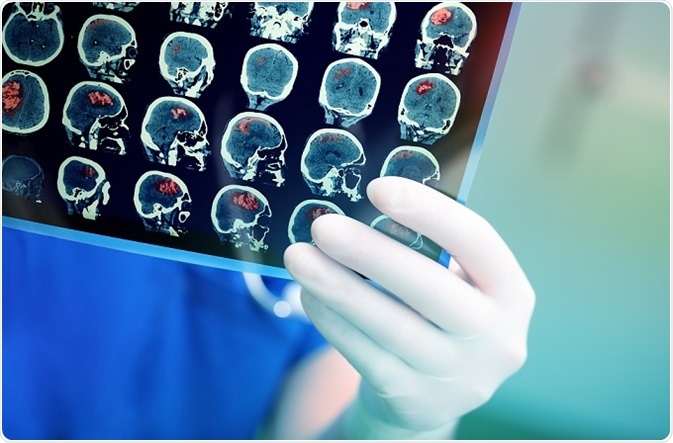https://www.news-medical.net/whitepaper/20180626/Using-Imaging-Techniques-to-Assess-the-Effects-of-a-Stroke.aspx
Cerebral ischaemia
Cerebral ischaemia is a type of stroke causing high rates of disability and mortality1. It occurs when blood vessels serving the brain become blocked or burst. This prevents the affected area of the brain from receiving sufficient oxygen and nutrients to meet its metabolic demands. © sfam_photo/Shutterstock.com
© sfam_photo/Shutterstock.comSymptoms of cerebral ischaemia may be fleeting if the interruption of blood supply to the brain is restored quickly, but if oxygen deprivation is prolonged the affected brain tissue will die causing irreversible brain damage. Cerebral ischaemia symptoms include sight disturbances, dizziness, loss of co-ordination, muscle weakness or paralysis, and difficulty speaking.
Changes in the brain after cerebral ischaemia
Cerebral ischaemia results in changes in energy usage, disruption to the metabolism of neurotransmitters and lipids and alterations to protein synthesis. In addition, intracellular cytosolic calcium concentration increases, as does the level of damaging free radicals. It is these metabolic, biochemical and ionic perturbations that ultimately cause neuronal death. Understanding the precise nature of these changes may therefore help in treatments to minimise the debilitating consequences of a stroke. However, since such a wide range of metabolites is affected, leading to disruption of several complex pathways, unravelling the effects of cerebral ischaemia is not straightforward.Furthermore, it appears that the pathological changes of stroke may be even more far-reaching than initially thought. Research indicates that metabolic changes occur not only in the area of the brain that has become ischaemic but may also induce secondary effects in other areas of the brain. Such functional impairment of the brain at a location removed from the injury site is known as diaschisis, which appears to be a form of shock response.
Defining and understanding the metabolic disturbances caused by oxygen and nutrient deprivation have this been identified as key to the development of treatments to minimise morbidity in patients suffering cerebral ischaemia2. With the possibility of diaschisis, the physiological effects of cerebral ischaemia must be evaluated across the brain and not just in the ischaemic area.
Magnetic resonance imaging and positron emission tomography have successfully measured remote metabolic changes after cerebral ischaemia. Such techniques have provided insight into the more far-reaching effects of stroke in areas of the brain far-removed from the ischaemic area. However, although cerebellar diaschisis has been well studied3, there are few data relating to the less common interhemispheric diaschisis. It remains unclear whether ischaemic damage in one hemisphere can lead to diaschisis in another hemisphere.
Measuring metabolic changes
Metabolomics is the study of biochemical pathways through the measurement of the metabolites. By determining the relative changes in concentration of substrate and product metabolites, it can be inferred whether specific pathways have been up or down-regulated. This methodology has been widely used across a range of disciplines to investigate the effects of drugs or contaminants.Nuclear magnetic resonance spectroscopy detects molecules based on their chemical shift on application of a magnetic field. Since different types of molecules give different spectral peaks, it can measure the many different components in a complex mixture. It has been widely used to investigate the pathological mechanisms of cerebral ischaemia, but has not to study the effects on biochemical processes within the brain.
Investigating inter-hemisphere effects of cerebral ischemia
A recent study investigated metabolite changes after cerebral artery occlusion in both the left and right cerebral hemispheres of rats4. In order to simultaneously measure the quantities of numerous metabolites, 1H nuclear magnetic resonance (1H NMR) spectroscopy was employed for the analysis using a Bruker AVANCE III 600 MHz NMR spectrometer. Characteristic changes in metabolites indicated that biochemical changes had occurred in both the ischaemic and contralateral cerebral hemispheres.In the ischaemic cerebral hemisphere, the changes in metabolites after cerebral ischaemia indicated an increase in anaerobic glycolysis, a perturbation of choline metabolism, neuronal cell damage and neurotransmitter imbalance. In the contralateral hemisphere, an increase in anaerobic glycolysis was also observed, along with changes in energy metabolism and alteration in the balance of neurotransmitters. Since the two cerebral hemispheres are connected by a large mass of neural fibres called the corpus callosum, it is likely that this is the means by which ischaemic damage in one hemisphere can initiate metabolic changes in the other hemisphere.
These findings indicate that interhemispheric diaschisis can indeed occur after cerebral ischaemia. Furthermore, they support cerebral metabolic analysis as valuable tool for understanding the biochemical mechanisms of cerebral ischaemia and its effects on distant areas of the brain.
References
- Anuncibay-Soto B, et al. Neuroprotection by salubrinal treatment in global cerebral ischemia. Neural Regen Res 2016;11:1744‑1745.
- Yang M, et al. NMR analysis of the rat neurochemical changes induced by middle cerebral artery occlusion. Talanta 2012;88:136‑144.
- Madai VI, et al. Crossed cerebellar diaschisis after stroke: can perfusion-weighted MRI show functional inactivation? J Cereb Blood Flow Metab 2011;31:1493‑1500.
- Ruan L, et al. Metabolite changes in the ipsilateral and contralateral cerebral hemispheres in rats with middle cerebral artery occlusion. Neural Regen Res 2017;12(6):931-937.
No comments:
Post a Comment